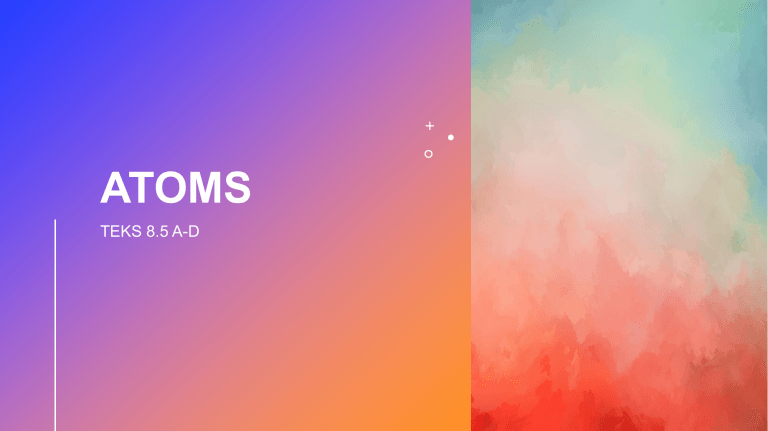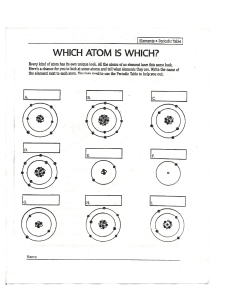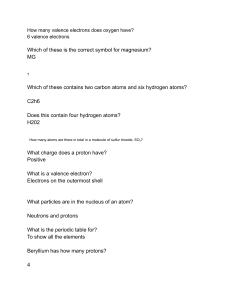
ATOMS TEKS 8.5 A-D What is an ATOM? Atoms are the building blocks of all matter. Matter is everything around us that takes up space and has volume. It is made up of very small atoms. What are atoms made of? • Atoms are made of protons, electrons and neutrons. • Protons and Neutrons are located in the nucleus. Protons have a positive charge and neutrons have no charge. • Electrons are located outside the nucleus in what is called the electron cloud. Electrons have a negative charge. • The number of protons equal the number of electrons. ATOMIC STRUCTURE (BOHR MODEL) Language of Atoms • Atomic Number is the number of protons (P) in an atom. The number of protons determines the identity of the atom. • Atomic Mass is the number of protons (P) plus neutrons (N) in the nucleus. • Valence Electrons are the number of electrons in the outermost energy level of the electron cloud. • Valence Electrons determine the chemical properties of atoms, including the reactivity of the atom. • Chemical Properties: Atoms with the same number of valence electrons will have similar chemical properties. • Reactivity: the reactivity of an atom is its capacity to undergo a chemical reaction with another atom. The capacity to react is determined by its valence electrons. Reactivity • The atoms that react most easily with other atoms have either the lowest number of valence electrons or the highest number of valence electrons. • Atoms with the lowest number of valence electrons are highly reactive because they seek stability by releasing valence electron(s) to other atoms. • Atoms with the highest number of valence electrons are highly reactive because they seek stability by gaining electrons to fill their outermost shell. Periodic Table • Groups of atoms have the same number of valence of electrons. • Elements in a group have similar properties because they have the same number of valence electrons. They are organized on the periodic table by columns. They are also called families. • Rows on the periodic table are called periods. Elements in a row or period have gradual changes in chemical properties going from left to right. Classifying Elements • Three physical properties that are useful for classifying elements: Luster, Conductivity, and Malleability. • Groups of elements with the greatest luster, greatest conductivity and greatest malleability are called METALS. • Groups of elements that are shiny but not lustrous, have a semi-conductive property and are brittle are classified as METALLOIDS. • Groups of elements that are mostly gases but include dull, brittle solids and display insulating properties are classified as NONMETALS. PERIODIC TABLE OF ELEMENTS • Elements with the properties of METALS are all left of the staircase. Most elements are metals. They are found on the left side of the periodic table. • Elements with METALLIOD properties fall along a staircase line. • Elements with properties of NONMETALS are all to the right of the staircase and hydrogen in the top left. Chemical Formulas • Molecules are formed when two or more atoms join (bond) together. • If a molecule is the same of the element, it is the molecule of an element. • Scientist use formulas to identify substances and determine the number of atoms of each element in each element containing subscripts. Formulas provide the following information: a Symbol determines the identity of the atom and a Subscript or number of each type of atom of the molecule.




